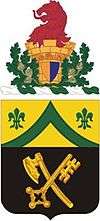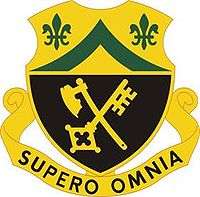81st Armor Regiment
The 81st Armor Regiment currently has two active battalions, the 1st and 3rd. The 1st Battalion is assigned to the 194th Armor Brigade, Fort Benning, GA. Responsible for training enlisted Armor Crewmen and Armor Maintainers for the US Army and US Marines on armored warfare vehicles such as the M1 Abrams Main Battle Tank, the M2 Bradley Fighting Vehicle and the Stryker platform.[1] The 3rd Battalion is currently the Provost battalion for the Maneuver Center of Excellence, Fort Benning, GA.
| 81st Armor Regiment | |
|---|---|
 Coat of arms | |
| Active | 1941 – present |
| Country | |
| Branch | Armor Branch (United States) |
| Type | Armor |
| Role | Armored warfare & maintenance training |
| Garrison/HQ | Fort Knox, KY past Fort benning, GA present |
| Nickname(s) | "Red Knights" |
| Motto(s) | Supero Omnia (Above All) |
| Colors | Gold, Black and Green |
| Engagements | World War II |
| Commanders | |
| Notable commanders | John T. Cole |
History and lineage of 1st Battalion and Regiment
The 81st Armor Regiment was activated on 1 October 1941 at Fort Knox, Kentucky.
In early 1942, the 81st Armor was moved to California with orders to defend against possible Japanese attacks. While stationed there, it was redesignated as the 81st Tank Battalion in 1943.
Shortly after their service in California, the 81st Tank Battalion headed to Europe in July 1944 to participate in the battles for Normandy and Northern France. The 2nd Battalion was reformed as Company B, 81st Armor and was successful in liberating Luxembourg City on 10 September 1944. As December 1944 crept closer, the battalion entered the Huertgen Forest in the Alsace Region of France. The battalion then rested and refitted for the final push into Germany. The unit spearheaded the 5th Armored Division's drive to the Rhine River and became the first unit to cross the Siegfried Line into the Rhineland, crossing the Rhine in March 1945. It then drove to the Elbe, 45 miles from Berlin, and was engaged in mopping up German resistance in the Ninth Army sector.
Upon returning from the battlefields of Europe, the battalion was deactivated in the fall of 1945. Except for seven months in 1950, it was active from 1948–1956 with the 5th Armored Division at Fort Chaffee, Arkansas. In 1962, the 81st and the 94th Tank Battalions and the 505th Replacement Company were redesignated as the 81st Armor under the Combat Arms Regimental System. The 1st and 2nd Battalions were assigned to the 1st Armored Division in February of that year. The 2nd battalion was deactivated in 1971 and reactivated in 1972 in West Germany. It was then deactivated again in 1989. The 2nd Battalion was once again reactivated in January 1996 as a part of the 1st Armored Training Brigade at Fort Knox, Kentucky. [2]
History and lineage of 3rd Battalion
The "Royal Lions" have performed a number of varied and challenging missions over the decades. The battalion was constituted on 28 August 1941, as Company C, 81st Armor Regiment and activated at Fort Knox, Kentucky, on 1 October of that year. Following America's entry into the Second World War, on 20 September 1943, the battalion was re-designated as the 707th Tank Battalion, where it saw combat as part of both the 5th and 7th Armored Divisions. As part of the drive through Europe the 707th participated in the campaigns of Normandy, Northern France, Rhineland, Ardennes-Alsace, and Central Europe. The 707th was awarded the Luxembourg Croix de Guerre, World War II streamer, for its outstanding wartime service. Following its successful campaigns in Europe the 707th was inactivated at Boston, Massachusetts, on 8 October 1945.
In the early months of the Korean War the battalion was re-designated as the 94th Medium Tank Battalion, 7th Armored Division and reactivated again on 24 November 1950, at Camp Roberts, California, where it remained until inactivated on 15 November 1953.
On 3 February 1962, the battalion was relieved from assignment to the 7th Armored Division and re-designated as the 3d battalion, 81st Armored Regiment under the Combat Arms Regimental System. The battalion was reassigned to the 5th Armored Division. On 25 March 1987, the battalion was relieved from assignment to the 5th Armored Division and re-designated at Fort Knox, Kentucky as a training battalion. On 1 October 1991, the battalion was again deactivated.
The current mission of the battalion begins with the creation, on 20 July 1965, of Committee Group. This unit was activated at Fort Knox with the mission of providing training support to Initial Entry Training soldiers. On 2 March 1986, Committee Group was re-designated as Training Group, the battalion was placed under the operational control of the 4th Training Brigade. On 30 July 1993, Training Group was re-designated 3d Battalion, 81st Armored Regiment and attached to the 1st Armor Training Brigade.
On 15 September 1997, the battalion accepted the attachment of the 233d Transportation Company (FORSCOM) from the 19th Engineer Battalion.
From 1 June 2004 through 30 April 2006 the battalion also had 3 Cavalry OSUT Troops attached: Golf, Hotel and India Troops from 6th Squadron, 15th Cavalry.
On 2 June 2010, the battalion assumed command and control of Delta Company, Echo Company and the Ordnance Training Detachment thereby assuming the mission of advanced individual training for 91A and 91M and Marine Corps armor instructors.
On 1 OCT 2014 the BN was re-missioned under the 199th INF BDE during the MCOE re-organization to serve as the Army's very first PROVOST BN. A CO departed to 316 CAV, OTD, E CO, and the Marines were moved to 1-81AR, and C CO became a part of 194th AR BDE. The new Battalion formed from THE MCOE Band, B CO 3-81 AR missioned to oversee the Maneuver Captain Career Course, P TRP 316 CAV with the IMSO mission, and HHC MCoE.
In its many forms and under various designations, 3d Battalion, 81st Armored Regiment has a long and proud history of service to our Army in time of peace and war.
Distinctive Unit Insignia

- Description
A Gold color metal and enamel device 1 1/8 inches (2.86 cm) in height overall consisting of a shield blazoned: Per fess enhanced Or and Sable, a chevron in point embowed between two fleurs-de-lis Vert and in base a battle-axe and key in saltire of the first. Attached below and to the sides of the shield is a Gold scroll inscribed "SUPERO OMNIA" in Black letters.
- Symbolism
The gold of the shield is the color for Armor. The fleurs-de-lis symbolize the organization's Normandy and Northern France campaigns. The chevron "in point embowed" recalls the Battle of the Bulge, the Ardennes-Alsace campaign. The key, occurring frequently in the civic arms of the towns of Rheinprovinz (the province in which the Rhine River crossing was made and the Siegfried line breached), symbolizes the Rhineland campaign. Symbolical of the important successes of this campaign, it allegorically represents the "Key to Victory" in Europe. The battle-axe, a favorite Teutonic weapon and heraldic charge throughout the entire medieval period, signifies the Central Europe campaign.
- Background
The distinctive unit insignia was originally approved for the 81st Medium Tank Battalion on 18 April 1953. It was amended to correct the spelling of the Latin motto on 19 April 1954. The insignia was redesignated for the 81st Armor Regiment on 31 January 1962.
Coat of Arms
Blazon
- Shield
Per fess enhanced Or and Sable, in chief a chevron in point embowed between two fleurs-de-lis Vert and in base a battle-axe and key in saltire of the first. Crest On a wreath Argent and Vert between two branches of oak Proper a tower Or charged with an escutcheon per pale Tenné and Azure and surmounted with a lion's head erased Gules. Motto SUPERO OMNIA (To Surpass All).
Symbolism
- Shield
The gold of the shield is the color for Armor. The fleurs-de-lis symbolize the organization's Normandy and Northern France campaigns. The chevron "in point embowed" recalls the Battle of the Bulge, the Ardennes-Alsace campaign. The key, occurring frequently in the civic arms of the towns of Rheinprovinz (the province in which the Rhine River crossing was made and the Siegfried line breached), symbolizes the Rhineland campaign. Symbolical of the important successes of this campaign, it allegorically represents the "Key to Victory" in Europe. The battle-axe, a favorite Teutonic weapon and heraldic charge throughout the entire medieval period, signifies the Central Europe campaign.
- Crest
The red lion's head is adapted from the Arms of the Duchy of Luxembourg and the gold tower alludes to the successful accomplishment of the unit's mission in that area in World War II. The oak leaves symbolize honor, victory and valor and the shield, in the colors of the Luxembourg Croix de Guerre, alludes to the award of that decoration to the 81st Armor.
Background
The coat of arms was originally approved for the 81st Medium Tank Battalion on 18 April 1953. It was amended to correct the spelling of the Latin motto on 19 April 1954. It was redesignated for the 81st Armor Regiment on 31 January 1962. The insignia was amended to add a crest on 25 November 1964. It was amended to correct the wording in the blazon of the crest on 29 October 1965.
References
Requesting additional information for the history of the 81st Armor Battalion.
![]()